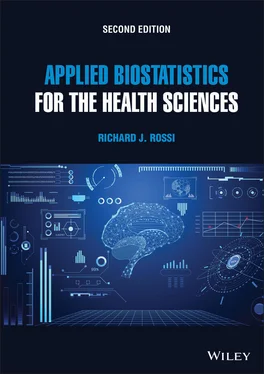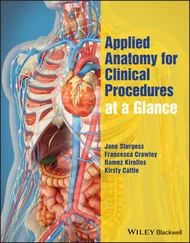Richard J. Rossi - Applied Biostatistics for the Health Sciences
Здесь есть возможность читать онлайн «Richard J. Rossi - Applied Biostatistics for the Health Sciences» — ознакомительный отрывок электронной книги совершенно бесплатно, а после прочтения отрывка купить полную версию. В некоторых случаях можно слушать аудио, скачать через торрент в формате fb2 и присутствует краткое содержание. Жанр: unrecognised, на английском языке. Описание произведения, (предисловие) а так же отзывы посетителей доступны на портале библиотеки ЛибКат.
- Название:Applied Biostatistics for the Health Sciences
- Автор:
- Жанр:
- Год:неизвестен
- ISBN:нет данных
- Рейтинг книги:3 / 5. Голосов: 1
-
Избранное:Добавить в избранное
- Отзывы:
-
Ваша оценка:
- 60
- 1
- 2
- 3
- 4
- 5
Applied Biostatistics for the Health Sciences: краткое содержание, описание и аннотация
Предлагаем к чтению аннотацию, описание, краткое содержание или предисловие (зависит от того, что написал сам автор книги «Applied Biostatistics for the Health Sciences»). Если вы не нашли необходимую информацию о книге — напишите в комментариях, мы постараемся отыскать её.
APPLIED BIOSTATISTICS FOR THE HEALTH SCIENCES Applied Biostatistics for the Health Sciences
Applied Biostatistics for the Health Sciences
Applied Biostatistics for the Health Sciences — читать онлайн ознакомительный отрывок
Ниже представлен текст книги, разбитый по страницам. Система сохранения места последней прочитанной страницы, позволяет с удобством читать онлайн бесплатно книгу «Applied Biostatistics for the Health Sciences», без необходимости каждый раз заново искать на чём Вы остановились. Поставьте закладку, и сможете в любой момент перейти на страницу, на которой закончили чтение.
Интервал:
Закладка:
| Variable | Description | Codes/Values | Name |
|---|---|---|---|
| 1 | Month | Month | Month |
| 2 | Time ridden | Minutes | Time |
| 3 | Average heart rate | Beats per minute | HeartRate |
| 4 | Average speed | miles per hour | Speed |
| 5 | Calories burned per minute | Calories/minute | Cals/m |
Glossary
BiostatisticsBiostatistics is the science of collecting, analyzing, and interpreting biomedical and healthcare data. Blinded StudyA blinded study is a research study where the subjects in the study are not told which treatment they are receiving. A research study is a double-blind study when neither the subject nor the staff administering the treatment know which treatment a subject receives. Case–Control StudyA case–control study is a retrospective study in which subjects having a certain disease or condition are compared with subjects who do not have the disease. CensusA census is a sample consisting of the entire set of population units. Clinical TrialA clinical trial is a research study performed on humans and designed to evaluate a new treatment or drug or to investigate a specific health condition that follows a predefined protocol. CohortA cohort is a group of subjects having similar characteristics. Cross–Sectional StudyA cross-sectional study is a study to investigate the relationship between a response variable and the explanatory variables in a target population at a particular point in time. ExperimentAn experiment is a study where the researcher controls the assignment of the units to the treatments. Explanatory VariableAn explanatory variable is a variable that is used to explain or is believed to cause changes in the response variable. The explanatory variables are also called independent variables or predictor variables. Longitudinal StudyA longitudinal study is a study where the same subjects are observed over a specific period of time. A longitudinal study could be either a prospective or a retrospective study. Observational StudyAn observational study is any study where the units of the study come to the researchers already assigned to the subpopulations or treatment groups. ParameterA parameter is a numerical measure of a characteristic of the population. Phase I Clinical TrialA phase I clinical trial is designed for investigating the safety, efficacy, and side effects of a new drug or treatment. Phase I drug trials are also referred to as dose finding trials. Phase II Clinical TrialA phase II clinical trial follows a phase I trial and is used to further investigate the effectiveness, feasibility, and safety of a drug or treatment. Phase II trials are also referred to as safety and efficacy trials and usually have a larger sample size than a phase I trial. Phase III Clinical TrialA phase III clinical trial follows a phase II trial and is designed to gather additional information that will be used in evaluating the overall benefit–risk relationship of the drug. Phase III trials are generally large trials and are referred to as comparative treatment efficacy trials. Phase IV Clinical TrialA phase IV clinical trial is a postmarketing study designed to obtain additional information on the risks associated with the drug/treatment, its benefits, and its optimal use. The primary use of a phase IV trials is to evaluate the long-term safety and effectiveness of a drug/treatment. Phase IV trials are referred to as expanded safety trials and usually involve a large number of subjects. Population UnitsThe units of a population are the objects on which measurements will be taken. When the units of the population are human beings, they are referred to as subjects or individuals. Prospective StudyA prospective study is a study that monitors the units over a period of time and analyzes what happens to the units in the study. Randomized Controlled StudyA randomized controlled study is a research study where the subjects are randomly assigned to the treatments with one of the treatments being a control treatment; a control treatment may be a standard treatment, a placebo, or no treatment at all. Response VariableA response variable is an observed variable or outcome variable in an experiment or study that is believed to depend on other variables in the study. The response variable is also called a dependent variable. Retrospective StudyA retrospective study is a study that looks backward in time and analyzes what has happened to the units in the study. SampleA sample is a subset of the population units. A random sample is a sample that is chosen according to a sampling plan where the probability of each possible sample that can be drawn from the target population is known and the probability of sampling each unit in the population is known. StatisticA statistic is any value that is computed from only the sample observations and known values. Statistical InferencesStatistical inferences are estimates, conclusions, or generalizations made about the target population from the information contained in an observed sample. Statistical ModelA statistical model is a mathematical formula that relates the response variable to the explanatory variables. Target PopulationThe target population is the population of units that is being studied. TreatmentA treatment is any experimental condition that is applied to the units. A placebo treatment is an inert or inactive treatment that is applied to the units. VariableA variable is a characteristic that will be recorded or measured on a unit in the target population.
Exercises
1.1 What is biostatistics?
1.2 What does a biostatistician do?
1.3 What are three federal agencies that employ biostatisticians?
1.4 What is atarget population?sample?census?
1.5 How is the target population different from a sample?
1.6 What is aparameter?statistic?
1.7 How is a statistic different from a parameter?
1.8 How can the value of an unknown parameter befound exactly?estimated?
1.9 What is a numerical value that is computed from only the information contained in a sample called?
1.10 What is a numerical value that is computed from a census called?
1.11 What is a statistical inference?
1.12 What is arandom sample?cohort?variable?treatment?placebo?statistical model?
1.13 What can be expected of an estimate of a parameter when the sample size is approximately equal to the number of units in the population?
1.14 What is the difference between a response variable and an explanatory variable.
1.15 In a study designed to determine the percentage of understaffed hospitals in the United States, 250 of roughly 7500 hundred hospitals in the United States were surveyed. The resulting percentage of the understaffed hospitals was 41%.What is the target population in this study?Is 41% a statistic or a parameter? Explain.
1.16 In a study designed to determine the percentage of doctors belonging to the American Medical Association (AMA) who perform pro bono work, the AMA found from a census of its membership that 63% performed pro bono work. The AMA also found from a sample of 1000 members that the average number of pro bono hours worked by a doctor in a year was 223.What is the target population in this study?Is 63% a statistic or a parameter? Explain.Is 223 a statistic or a parameter? Explain.
Читать дальшеИнтервал:
Закладка:
Похожие книги на «Applied Biostatistics for the Health Sciences»
Представляем Вашему вниманию похожие книги на «Applied Biostatistics for the Health Sciences» списком для выбора. Мы отобрали схожую по названию и смыслу литературу в надежде предоставить читателям больше вариантов отыскать новые, интересные, ещё непрочитанные произведения.
Обсуждение, отзывы о книге «Applied Biostatistics for the Health Sciences» и просто собственные мнения читателей. Оставьте ваши комментарии, напишите, что Вы думаете о произведении, его смысле или главных героях. Укажите что конкретно понравилось, а что нет, и почему Вы так считаете.












